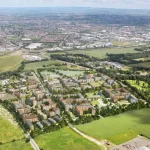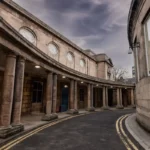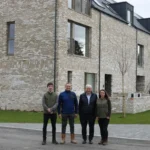Edinburgh News November 2013 : Buildings in Scotland
Edinburgh News : November 2013
Lothian Building Developments – Property News in Eastern Scotland
Edinburgh Building News – November 2013
Lothian Architecture Design News
131-133 Princes Street
BAM Properties has lodged a planning application with Edinburgh City Council to create a new Halifax flagship retail banking branch at 131-133 Princes Street, along with an upmarket restaurant and bar with private rooms on the upper floors.
131-133 Princes Street has been selected by Halifax as one of the locations to launch its retail brand in Scotland, along with sites in Aberdeen and Glasgow. A number of financial services jobs would be created in Edinburgh.
The building was previously occupied by retailer GAP and has lain vacant for more than three years despite a £1.7m investment in upgrading the store. Halifax is keen to invest in the building to provide customers with a high quality state of the art retail branch. 29 Nov
PoLHA Albion Road Building
Port of Leith Housing Association (PoLHA), in conjunction with its subsidiary company, Persevere Developments Limited, has started work on its Albion Road development and is set to be completed in the autumn of 2015.
The 42 affordable homes, made up of 10 one bedroom, 25 two bedroom and seven three bedroom properties, are being built for social and mid market rent. 29 Nov
New Urbanism in Longniddry
Update from Socially Conscious Capital Limited: “The developer behind this project is Socially Conscious Capital. The Prince’s Foundation are not a developer, they merely facilitated the Enquiry by Design workshop to engage with the local community, and use their feedback to compile a vision for the sustainable growth of Longniddry.
We are conscious that few, if any, developers engage with the local community at this stage in the process and it should be highlighted that these are merely proposals for discussion with the local community. The principle of development has not been decided on, let alone the architects and whether development goes ahead will be a decision taken by East Lothian Council. New Urbanism is not a style, it refers to urban design and any style will likely aim to reflect the village character, and aim to preserve its appeal and history”. 19 Nov
Conservation Area Regeneration Scheme
£10 m funding boost for Scotland’s historic towns and cities
Communities across Scotland are set to benefit from the latest round of Conservation Area Regeneration Scheme (CARS) funding announced today.
The £10 million was outlined by Fiona Hyslop, Cabinet Secretary for Culture and External Affairs during her keynote speech at the Built Environment Forum Scotland (BEFS) Annual Congress in Linlithgow.
This is the sixth round of CARS funding, with £26 million having been invested by the Scottish Government in projects across Scotland since the first grants were made in 2007. Applications for this round will open early in the new year with a closing date of 31 August 2014.
CARS specifically targets conservation areas with social and economic disadvantages that make it difficult to attract investment in sustainable regeneration. The scheme assists these areas through channelling funding towards opportunities to enhance sustainable economic growth and help support projects that develop an area’s sense of place.
Ms Hyslop told BEFS delegates that the scheme has clearly demonstrated it is a catalyst to attract funding from other sources. In the scheme’s first year, £6.7 million was invested through CARS, delivering improvements to 28,000 sq m of public realm, and the rejuvenation and reuse of 15,000 sq m of vacant floor space. This investment attracted a further £18.6 million from other sources – a leverage of extra funding of 3 to 1.
The Cabinet Secretary said: “This investment will build on the considerable benefits that CARS is already delivering for communities across Scotland since 2007. It will help reinvigorate our villages, towns and cities and give people a sense of place and pride in their surroundings.
“Investment in our historic environment is key to contributing to an improved quality of life for many people across Scotland. Not only does CARS breathe new life into our communities it is instrumental in stimulating economic growth through new employment opportunities and promoting traditional skills as well as boosting the local tourism industry.”
Ms Hyslop added: “Today’s announcement demonstrates that we are committed to delivering for Scotland’s historic environment and placing it at the heart of our communities.”
Cllr Stephen Hagan, COSLA spokesperson for Development Economy & Sustainability commented: “COSLA welcomes the announcement of a new round of funding for CARS and the support it gives to regeneration of our historic areas. Since 2007, a large number of communities across Scotland have already benefitted from this funding stream and I look forward to seeing the impact this latest investment will help deliver.”
John Pelan, Director of the Built Environment Forum Scotland said: “BEFS welcomes the news of the Scottish Government’s continued support for CARS which our Small Towns Initiative Report highlighted as playing an important role in the regeneration of places such as Campbeltown, Kilsyth and Stornoway. BEFS is pleased that the Cabinet Secretary continues to focus on the issue of ‘mainstreaming’ the historic environment as an integral part of the fabric of Scottish society and welcomes her participation in its Annual Congress.”
CARS is open to Local and National Park Authorities, community groups and other third sector organisations delivering multi-funded projects. The funding can be utilised for a number of purposes from priority repairs and small grants to homeowners and retailers, to providing traditional craft training opportunities.
Today’s funding announcement comes on the back of an independent analysis of Historic Scotland’s investment across all its funding streams between 2007-12. The analysis shows that Historic Scotland’s financial support has generated an additional £166 million of investment in the historic environment. 19 Nov
Scottish Architects win at UK Property Awards
A leading Scottish architects firm, McKenzie Strickland Associates, has been named among the winning companies of the esteemed UK Property Awards for 2013.
The Perthshire-based practice competed against a number of architects in Scotland to receive its 14th industry award in just seven years. The company was presented with the award at a high-profile gala and presentation dinner at the Grosvenor House Hotel in London last month.
It won highly commended in The Best Architecture For A Single Residence category for its stunning project at No 1 Rosemount, Rosemount, Blairgowrie, Perthshire. Its remit was to design a modern family home sympathetic to an established area. The existing Rosemount cottage was demolished and the new woodland house designed to occupy the previous footprint with a strong connection between the natural landscape and generous open plan living spaces internally.
It follows other award wins for the firm which is based in Aberfeldy and Crieff and has an international client list – including for ‘The Best Commercial Redevelopment in the World’ in the International Property Awards 2011.
Stuart Shield, president of the International Property Awards, said: “In such a highly industrialised region as the United Kingdom, the standards for excellence are very high. These winning companies have stood out from the crowd by creating unique and innovative properties that elevate the character and appearance of UK towns and cities.”
The UK Property Awards are part of the long established International Property Awards, the world’s richest competition when measured by the value of the projects entered. The award winners’ logo is recognised as a symbol of excellence throughout the global industry.
The awards rank amongst the most prestigious commendations in the residential and commercial property sectors. A high-calibre jury of international experts identifies the most significant building projects as well as the highest quality UK estate agencies, property consultants and industry websites and marketing campaigns.
The judging panel consisted of approximately 70 professionals including Andrew Panting, Director of Operations for the British Property Federation, Peter Bolton King, Global Residential Director of the Royal Institute of Chartered Surveyors (RICS); and Christian Morris, Director / Owner of architectural firm Yotomo Ltd. 18 Nov
Edinburgh Conference News
13 November 2013 – Shrinking urban areas can reimagine how cities work, say experts
The depopulation of North American and European cities can be an opportunity to reinvent how urban spaces operate and function, according to experts.
Urban farming, new creative public spaces, and inner-city wildernesses are among the innovations that citizens can employ when urban populations start to decline.
The University of Edinburgh is hosting a special conference to discuss how this contraction actually presents opportunities for communities. International experts will share how cities around the world manage underutilised land.
In Thessaloniki, Greece, for example, locals have taken over an abandoned military camp and are farming in ad hoc collectives. In Chicago vacant lands are being explored as native seed banks for potential natural capital restorability.
In Sarajevo, Bosnia, the city’s south-eastern edge has shrunk following the war in the 1990s. The wilderness from nearby Mount Trebevic has now swept in and reclaimed urban areas. In East Germany Leipzig is one of the most successful examples of underused urban land being converted into green spaces.
And in the Great Lakes region of the US, cities are planning on using vacant plots to innovate how they manage storm water and reduce flood risks.
A great number of European and North American cities are shrinking, according to recent figures gathered by Professor Karina Pallagst from Kaiserslautern University of Technology, the conference’s keynote speaker.
180 out of 280 North American metropolitan areas are either stagnant or declining. In Europe, 57% of 220 large and medium size European cities, and 54% of the larger urban areas lost population between 1996 and 2001.
The conference organiser Francisca Lima, from the University’s Edinburgh School of Architecture and Landscape Architecture (ESALA), said: “Urban shrinkage doesn’t necessarily mean a dead end scenario for cities. Many examples worldwide indicate that when the challenge is acknowledged and creatively faced, positive outcomes can arise.”
Fellow organiser Mark Eischeid said: “The conference and associated exhibitions will bring scholars, designers and artists from around the world to share the latest thinking regarding opportunities presented by underutilised lands.”
Shrinking Cities | Expanding Landscapes takes place 14-16 November.
The conference begins with a free public keynote address by Professor Pallagst on 14 November at 5pm in the Main Lecture Theatre of Edinburgh College of Art (ECA), Lauriston Place.
Two exhibitions exploring urban abandonment and speculative design interventions accompany the conference at ECA’s Sculpture Court, located in its Main Building.
For further information, please contact:
Edd McCracken, Press and PR Office, tel 0131 651 4400; email edd.mccracken(at)ed.ac.uk
Historic Scotland News
Extensive investment in the historic environment by Historic Scotland over the past five years has levered in over £166 million of additional funding.
An independent analysis commissioned by Historic Scotland and carried out by Jura Consultants assessed the impact of a range of investments from 2007-12. These include: Conservation Area Regeneration Schemes, Historic Building Repair Grants, City Heritage Trusts, Archaeology Grants, Ancient Monument Grants and Voluntary Sector Grants. Case studies looked in detail at the process and how it delivered benefits on the ground.
The highly oversubscribed Conservation Area Regeneration Schemes (CARS) invested £27 million in communities across Scotland in the past five years. £6.7 million was invested in 2007, delivering improvements to 28,000 sq m of public realm, and the rejuvenation and reuse of 15,000 sq m of vacant floor space. This investment attracted a further £18.6 million from other sources.
In addition, from 2007-12, more than 259 buildings benefited from a Building Repair Grant, with funding for a broad range of conservation and restoration projects totalling £33 million. Many of the properties which received monies to carry out works are visitor attractions or are open to the public on a regular basis, and the report concluded that for every pound invested via the programme, £4.50 is generated from other sources; a total of £147.5 million.
Fiona Hyslop, Cabinet Secretary for Culture and External Affairs said: “Our heritage is dynamic, rich and inspiring, and its social, cultural and economic benefits are wide-reaching, as the analysis of the extensive impact of recent grant investment illustrates. Investments in our historic environment over the past five years have been a catalyst for a further £166 million of investment in our communities, and these figures highlight the key role grants from Historic Scotland play in regenerating our town centres and supporting tourism.”
The report is published as the Scottish Government issues its response to the consultation on the draft Historic Environment Strategy for Scotland and proposed creation of a new lead body to support its delivery. The vision and aims of the Strategy have been widely supported.
The consultation response outlines the proposed merger bill between Historic Scotland and the Royal Commission on the Ancient and Historical Monuments of Scotland (RCAHMS). The Bill will create a new Non-Departmental Public Body to ensure that maximum public benefit is delivered for Scotland’s historic environment.
For legislative purposes the new body will be called Historic Environment Scotland, however the key brands such as Historic Scotland, Canmore, the National Collection of Aerial Photography (NCAP) and Scran will be retained. The new body will be able to choose a public-facing name for itself after further work to establish how this might fit with existing brands.
The response has been published on the day that the Scottish Government launches a Town Centre Action Plan, which sets out a cross-government response to Community and Enterprise in Scotland’s Town Centres, a report produced by the External Advisory Group in July which outlined a vision for Scotland’s town centres, concentrating on community, enterprise and place.
Chairman of the National Trust for Scotland, Sir Kenneth Calman said: “The Trust welcomes the proposals and the manner in which the Scottish Government has positively engaged with us and others in the conservation and heritage sectors. The strategy that has emerged provides a useful framework for the merger of Historic Scotland and RCAHMS. We look forward to working with the Scottish Government and other partners in helping to conserve Scotland’s unrivalled heritage and contributing to the development of a successful and sustainable historic environment sector.”
Director of the Society of Antiquaries of Scotland and Vice Chairman of the Built Environment Forum of Scotland, Dr Simon Gilmour said: “We have been inspired and challenged by the collaborative formation of the first ever strategy for Scotland’s Historic Environment and look forward to working with the proposed new body to build on the existing strengths made so apparent in this report. This is an excellent opportunity for us all to engage, influence and deliver something which will have a lasting legacy for Scotland’s future generations.”
Fiona Hyslop added: “Our heritage is of us all and for us all, and it is crucial that we should all have the opportunity and the enthusiasm to participate in and celebrate it. Maintaining and restoring the historic buildings in our villages, towns and countryside not only enhances our surroundings and encourages additional investment, but has a positive impact on our communities, our pride and sense of self.” 7 Nov
Examples of Historic Scotland Grants on the Glasgow News page for November 2013.
Summary of the report by Jura Consultants on Historic Scotland’s investments from 2007-12
Jura Consultants was commissioned by Historic Scotland in February 2013 to assess the impact of its investment programmes in the historic environment, helping to inform how to best target future activity.
These programmes included: Conservation Area Regeneration Schemes; Historic Building Repair Grants; City Heritage Trusts; Archaeology Grants; Ancient Monument Grants and Voluntary Sector Grants. Case studies were prepared which looked in detail at the process and how it delivered benefits on the ground.
The analysis examined the type and scale of the economic, environmental and social impacts the various investments have had over the past five years. Respondents interviewed for the report also noted that repairing and restoring local landmark buildings has had a positive impact on people’s sense of place and pride in their local area, has encouraged community engagement and animated public spaces.
The findings of this study are to be used to provide evidence on the economic, social and environmental impacts created by investment but also to inform the ongoing Review of Historic Environment Policy in Scotland. The impact assessment was designed to:
• Collect data on the types of economic, social and environmental impacts created by grant investment made by Historic Scotland.
• Assess the extent to which the outputs of projects have contributed to achieving Scottish Government policy.
• Identify how grant programmes can be refined or revised to deliver greater impact against Scottish Government policies.
As part of the Conservation Area Regeneration Schemes, Historic Scotland’s investment of £6.7 million in 2007 attracted a further £18.6 million of investment from other sources, delivering a leverage factor of almost 3:1.
Across the 13 project areas, CARS funding contributed to:
• 40 Priority Projects, enhancing or finding new uses for historic buildings.
• 247 small grants distributed to homeowners and businesses to repair historic building fabric.
• Enhancement of over 28,000 sq m of public realm.
• Rejuvenating and bringing back into use over 15,000 sq m of vacant floor space.
A wide range of community engagement and training programmes were delivered alongside the physical regeneration of areas in receipt of CARS funding.
From 2007-12, more than 259 buildings benefited from a Building Repair Grant, with funding for a broad range of conservation and restoration projects totalling £33 million.
Many of the properties which received monies to carry out works are visitor attractions or are open to the public on a regular basis, and the report concluded that for every pound invested via the programme, £4.50 is generated from other sources; a total of £147.5 million.
In addition to highlighting the considerable economic impact of the grants programme, the report to analyse its impact concluded that 67 per cent of the projects aided by the Building Repair Grants scheme would not have gone ahead without the funding they received. 7 Nov
New Designs for Classrooms in Edinburgh
Detailed designs for 17 new classrooms to alleviate overcrowding at five of the Capital’s most popular primary schools have been unveiled, reported the Edinburgh Evening News today. The new buildings – which will also provide five general purpose spaces for PE, music and other activities – will be located at Liberton, Craigour Park, Broughton, Victoria and St David’s primaries.
The designs were revealed as the Capital battles to create new teaching space amid a double-digit boom in P1 enrolment numbers across the city. Primary school rolls in the city are predicted to rise by around 15 per cent by 2019. The new designs are part of phase two of the council’s rising rolls programme, with education leaders considering whether and how capacity could be boosted at ten Edinburgh primary schools. 1 Nov
Kisimul Castle News
Kisimul Castle of the Isle of Barra is regarded as the most significant medieval castle in the Western Isles. As part of the conservation plan announced today, three key projects will be completed by the end of 2015: re-roofing the flat roof over the hall; reinforcing concrete structures and overhauling the chapel roof and incorporating a new timber walkway.
Upgrading works to slipways at the castle and on the shore will follow at a later date. Historic Scotland have made special efforts to record local knowledge of the source of materials used to build the castle. In this way, it should be easier to more accurately conserve the fabric of this ancient monument. 1 Nov
Edinburgh Building News October 2013 – news in full from October 2013
Edinburgh Building News Summary
Comments / photos for Edinburgh Architectural News for November 2013 page welcome



